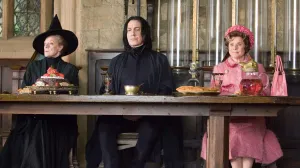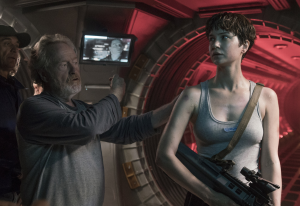Literature and horror movies have a long history together, with iconic books being the source of a variety of scary movies, while films would often get novelized interpretations of their narratives back in the ’70s and ’80s. With The Legend of Halloween, some of the minds behind 2018’s Halloween have embraced that concept while giving things an all-new spin, as they have brought to life an illustrated novelization of 1978’s Halloween, complete with adorable illustrations. The adaptation was co-written by David Gordon Green, who co-wrote and directed the 2018 Halloween, while author/director Onur Tukel also serves as a co-writer, with Tukel having illustrated the adaptation. Malek Akkad and Ryan Freimann, producer and executive producer of the 2018 Halloween and forthcoming sequels, oversaw the project from Further Front Publishing. You can pre-order your copy of the book at LegendofHalloween.com.
Videos by ComicBook.com
The book is described, “Originally premiered in the fall of 1978, Halloween inspired a generation of innovative horror films and a slew of franchise sequels and reboots. The Legend of Halloween follows the iconic villain Michael Myers as he wreaks havoc on his hometown of Haddonfield, Illinois, on Halloween night. Laurie Strode, originally portrayed by actress Jamie Lee Curtis, falls victim to the escaped killer, but manages to fight for her life and confront her new foe along the way. Through eerie rhymes and quirky illustrations emulating the unsettling nature of the classic horror journey, Green and Tukel craft a reimagined telling of the beloved source material for longtime fans and newcomers to the franchise.”
ComicBook.com recently caught up with Freimann to discuss the origins of this project, the mystery of Michael Myers, and what the future could hold for the franchise.

ComicBook.com: There’s a long history of adapting horror movies into novels, with the 2018 Halloween also getting a novelization, despite that trend having dwindled in recent years. With The Legend of Halloween, what was the genesis of the project?
Ryan Freimann: I think it was about eight years or so ago, I saw this guy doing these drawings that were single-shot recreations from very R-rated films done within total kids’ illustrated style. It was Seven, and David sees the box. “What’s in the box, David?” That kind of thing, where it was Chinatown or Scarface, it was this very weird juxtaposition of kids’ books with these R-rated scenes, and then the writing under it was done in a kids’ book style. I have kids of my own, and in the last few years, I started buying them these books that I came across. They’re these kids’ versions of Back to the Future and Karate Kid and Home Alone.
I was buying those for my kids, and I took those to Malek and said, “This would be a really interesting concept. It’s a cool juxtaposition.” He really liked the idea, but we’re in the horrible horror movie business and not the kids’ book business. And so, although we both thought it was a great idea, we had to put it to the side, and he said, “Maybe that day will come.” Well that came to happen that we shoot Halloween Kills, and David Gordon Green gets together with this author/illustrator friend of his, Onur Tukel, and they created a wrap gift for the cast and the crew of this kids’ book version a little loosely based on the Halloween Kills story, but they were doing exactly what we had talked about previously.
When quarantine happened and the lockdown started, we had to obviously push off Halloween Kills. We had to push off the shooting of Halloween Ends. We were left with this vacuum of, “What can we look to do?” And it came like, “Hey, why don’t we tackle these things that we wanted to do for a while that we haven’t done.” We got David on board, he loved the idea. It was like that parallel thinking where he had come up with this great idea that we had also had. So it was a match made in heaven.
That’s awesome that it came about so organically that it didn’t have to be, “Well, we want to do this and we have to convince David to do it.” He’s clearly the right person for the job.
Proving that great minds think alike mentality or whatever, and not to give myself too high, lofty of an opinion on my mind, but we had the same idea for doing this. It’s a cool thing.
When it came to going from this really cool idea to actually moving forward with the book, what was the biggest challenge with making it a reality? Was there anything that you thought would be a challenge that ended up being super fun or super exciting or a really seamless part of this journey?
I think there’s two facets to it. One is on the art side. How do you do a movie that has nudity, blood, and a brother killing their sister? How do you bring that into an art direction that is an approachable concept? So, much like how the film doesn’t really have a ton of blood — I mean, obviously Judith gets killed at the beginning and we see blood in other places, but it’s not these buckets of blood sloshed all across the screen. The book is true in that form. We don’t show any nudity. It’s a very friendly approach.
The second part is we wanted to tell the entire story that John Carpenter and Debra Hill came up with but in a way that is family, kind of kid-friendly. David and Onur want to … they did amazing work coming up with, and you could see from the three images that we released through the Entertainment Weekly exclusive, there’s these rhyming verses that they came up with for each scene and they take us through the entire story. It was both setting that art to the word and conveying the whole picture or the whole film in a new and imaginative way, but you end up at that same place. You now know the story.
You mentioned figuring out a way to make this relatable or accessible to potentially younger audiences without being super gory or super gruesome. Would you say this is kid-friendly, is it teen-friendly? Is it like Goosebumps or like Scary Stories to Tell in the Dark? Is this for macabre kids, or what would you say?
I think the line we use on the back cover is something, a book appropriate for, and then, in parentheticals, “almost all ages.” Would I show it to a four- or five-year-old, six-year old? My youngest son is six and a half. Now he’s a little more savvy to the Halloween world because his father works in it, you see this stuff a lot, you’re there. But I would have no problem showing it to my daughter who is 11 and my son who is nine. They would have zero problems with it. Now, there definitely are knives and there’s the depiction of stabby-stabby and this and that, but the rhyme scheme that matches it is very delicate and gentle. It’s this fun, tongue-in-cheek juxtaposition of those things.
What’s interesting specifically about Michael Myers is that, he’s not like Freddy Krueger or like Jason Voorhees where they’ve gotten a TV series or anything. He’s a big-screen killer. All of his kills are on the big screen. Whether it be in the films you’ve been working on or with this book, what do you feel it is about Michael Myers that makes him such an interesting, complex, compelling figure to tell stories with?
I think it’s the blank slate, if you will, that he is, in that his face is devoid of emotion and he never speaks, and he walks at this even clip. It allows the viewer to ascribe a certain level of fear to him based on whatever they might perceive it as. It’s The Boogeyman or The Shape that lives in your mind. I think, obviously, he carries out brutal action so that, by his very virtue, makes him scary, but it’s the unknown that hides and the questions that are constantly lurking. Like, what motivates him? What is he thinking? What did he eat? He is just a very interesting character that allows a lot of play in the mind of the viewer.
Making a kids’ book is a new endeavor for you, but do you think this has opened the door for you to pursue more? Have you started thinking of other horror movies you’d like to give the kids’-book treatment?
100% we’d be looking to do that more. We could look at other films in the franchise and then expand outward. I think that it’s an interesting take on things, an IP that people love. At the end of the day, whether it’s you produce horror films or comedies or dramas, you’re a storyteller, and so it’s finding creative new ways to tell stories to the world.
I saw there were little teasers and almost motion comics of just putting some motion to the illustrations from this book that were super effective and adorable, and, especially knowing that we don’t have the tradition anymore of making new animated specials like Garfield’s Halloween Adventure or It’s the Great Pumpkin, Charlie Brown — they did the David S. Pumpkins animated special a couple of years ago — but have there been talks of maybe doing a Michael Myers animated project out of this?
Those were great, and I do agree they were super effective. They bring back that ’70s or ’80s cartoon vibe that bring us back to nostalgia for the original film. When we started thinking of cool ways of promoting it, that was one of the ways that our illustrator had come up with. When he showed us just a couple rough ideas, we were like, “Yes, yes. 100% yes. Let’s figure out how we do these.” I’ve gotten a couple of comments and seen a couple others on different posts and people are hot about it, and I would love to explore … I don’t know where you’d show it. That would be an interesting thing and it would open up a lot of storyline issues, but definitely a cool concept. Seeing it come alive, seeing the animation come alive, they did definitely trigger some creative thoughts.
I’m kind of surprised that Blumhouse doesn’t already have their own streaming service. I know there’s Netflix and Shudder and stuff, but I don’t know why Blumhouse doesn’t just start their own streaming platform. And so that way they can get it on there.
Well, yeah, they have so many output deals with everybody else between Hulu and Showtime and a couple other places. I think they’re good at what they do and putting movies together, and they’ll let somebody else handle the distribution stuff.
With Halloween Kills, we get to see the characters Nurse Marion, Lindsey Wallace, and Tommy Doyle come back, and I’ve spoken to Tom Atkins and Danielle Harris previously about their Halloween films and their interest in showing up in a new Halloween, so when it comes to pulling off these exciting character returns, do you approach it as, “How can we bring these characters back?” or do those appearances come organically?
It’s totally organic. We’re not trying to shoehorn anybody in, and I think that it was appropriate for the story and Halloween Kills to bring these people back. And if it was appropriate in the story and, subsequently, Halloween Ends or other films in the future, so be it. I know the fans love both Tom and Danielle, as we all do, so I think it’s a fine line we’re walking between. We’re not trying to go for just the cameo for the sake of having a cameo. It really does work for the purpose of the story.
You mention Halloween Ends, which is set to come out in 2022, but we’ve seen many times that you can’t really kill the Halloween franchise. Have there been any preliminary discussions about what the plans for the series could be after that film comes out?
I have not thought that far ahead. Right now, we’re in the midst of what we see as the David Gordon Green trilogy. And the story, like with the Rob Zombie films, it had these little offshoots. They had done Halloween III: Season of the Witch way back then, so it’s like we’re living in the moment with these films that are successful, and we’ll see where it goes from there. I hope there is a theatrical experience. The future is still in place, but for right now, yes. It just speaks to me and Malek.
*****
You can pre-order your copy of The Legend of Halloween book at LegendofHalloween.com. Halloween Kills hits theaters on October 15, 2021 and Halloween Ends hits theaters on October 14, 2022.








